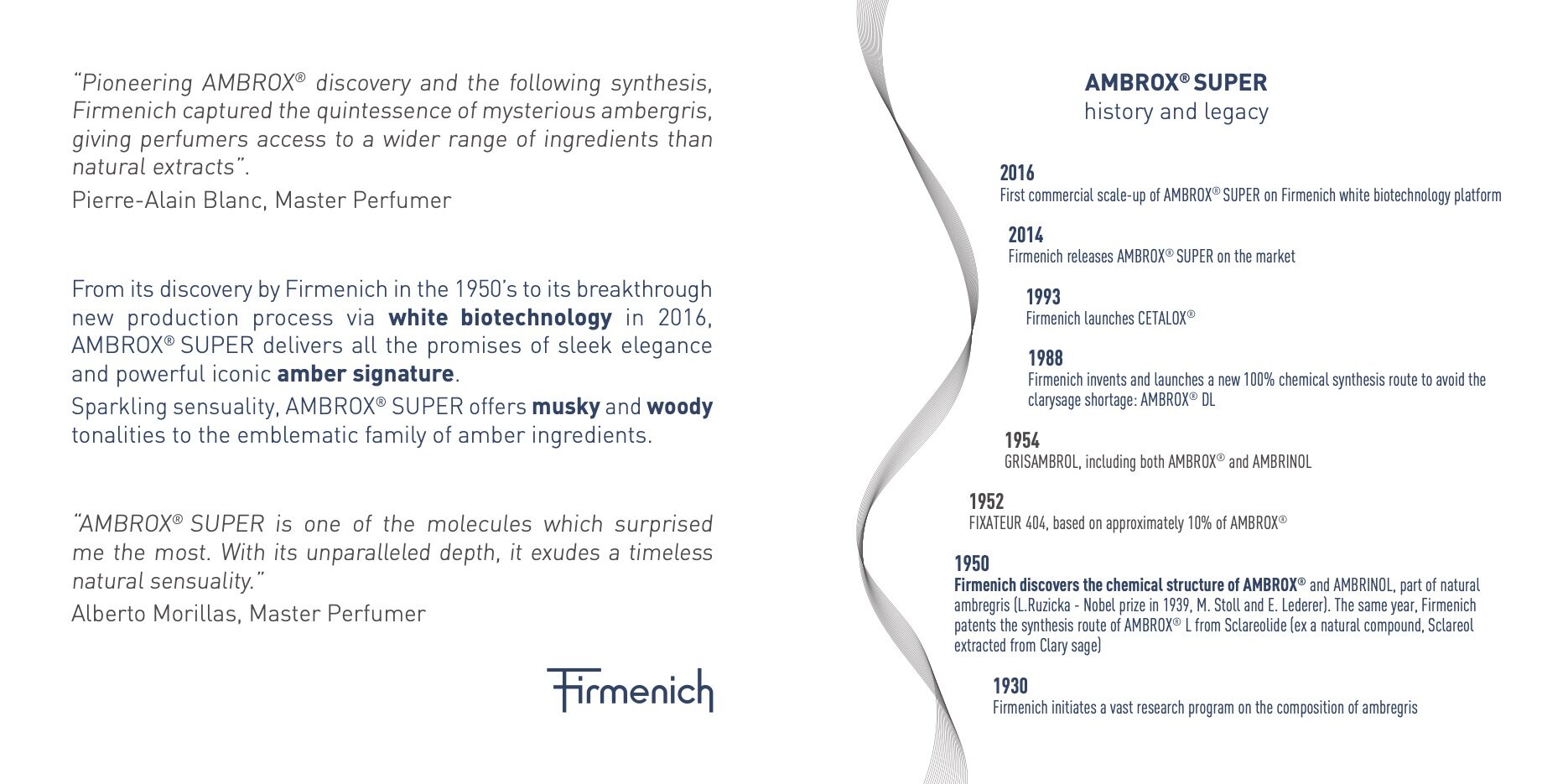AMBROXAN
AMBROXAN: The Evolution of a Synthetic Fragrance Ingredient
Synthetic Ingredient For Perfumery Overview
Ambroxide, widely known by the brand name Ambroxan or Ambrox, is a naturally occurring terpenoid and one of the key constituents responsible for the odor of ambergris. It is an autoxidation product of ambrein. and was it’s Discovery date around 1949-50
IUPAC: 3a,6,6,9a Tetramethyldodecahydronaphtho-[2,1-b]furan.
History
Ambroxan was discovered around 1949 and 1950 but the first (registered) use date 1976. Few years later, in 1982 by the company Henkel filed a trademark registration for Ambroxan ®
Another Trademark registration under the name Ambroxan ® was file in 2004 by the Japanese Kao Kabushiki Kaisha (we know it as KAO chemicals)
What is Ambroxan?
Ambroxan, is a diterpenoid and a chemical compound from the class of tetra labdane oxides. Derived from sclareol that is responsible for the odor of ambergris (a solid, waxy, flammable substance produced in the digestive system of sperm whales). It is an organic heterotricyclic compound and a diterpenoid.
Ambrox is considered to be one of the most valuable animal scents besides civet and musk.
It is produced by the reaction of ambergris (main component of the grey ambergris, a waxy substance from the digestive tract of sperm whales) with atmospheric oxygen. Ambrox also occurs in small quantities in the following sources:
Absolute of Tobacco (Nicotiana tabacum)
Muscat Sage (Salvia sclarea)
Cistus (Cistus labdaniferus)
Funeral Cypress (Cupressus sempervirens)
Ambroxide is synthesized from sclareol, a component of the essential oil of clary sage. Sclareol is oxidatively degraded to a lactone, which is hydrogenated to the corresponding diol, The resulting compound is dehydrated to form ambroxan. Ambroxide is used in perfumery for creating ambergris notes and as a fixative.
It appears as white crystals \ flakes. depending on the purification method and synthesis.
Profile:
📂 CAS N° 6790-58-5
⚖️ MW — 236.39 g/mol
📝 Odor Type — Ambery
📈 Odor Strength — High, recommended smelling in 10% DPG SOL.
👃🏼 Odor Profile — Ambroxan smell is clearly ambery. It's close to a mixture of iso e super and ambrox DL. Woody, pine, cedar-like with a green seedy and tea-like nuance. Labdanum notes.
👅 Flavor Profile — Woody and fresh, with a piney and nutty nuance. cedarwood, floral, leather-like, slightly tobacco note, and dry musk-like aftertaste. balsamic amber-like.
⚗️Uses — Ambrofix is a highly powerful, highly substantive, and highly stable ambery note for use in all applications. The most suitable material for obtaining an authentic ambergris note. Small amounts (< 0.01 ppm) are used as a flavoring in food.
Note — Produced from a natural starting material, this chiral product contains one main high impact isomer. Effective from the smallest traces, through to 2% or even more and lasts for over a month on a smelling strip. One of the most useful chemicals in modern perfumery.
Production
Ambrein is no longer used to obtain ambrox; it is replaced as a source material by sclareol from Salvia sclarea. With the publication of the first partial synthesis in 1950 by Firmenich, an alternative source of Ambrox was found. The key step of the technical synthesis is the oxidative degradation of the side chain with chromium trioxide CrO3. The subsequent reduction of the lactone with lithium aluminum hydride leads to the diol, which cyclizes in the presence of acids to the desired ether. As a by-product the thermodynamically more stable 9b-epi-Ambrox can be formed. The reaction can be carried out on an industrial scale with a yield of 54 %.
After the patent expired in the early 1980s, further technically feasible synthesis routes were published. A degradation reaction of sclareol using sodium periodate (instead of potassium permanganate) was published in the working group of Sir Derek H. R. Barton and a patent application was filed.
Modern time discovery from Givaudan
Only in the past years Givaudan has created a new production method for ambrofix via biotechnology.
The Swiss giant has developed a completely unique multi-step bioconversion process to produce Ambrofix from sugar cane.
This new process is considered the most sustainable process for Ambrofix in the market. All carbon atoms of the bio based starting point material are ending in the product — no carbon wasted leading to optimal carbon efficiency. Also it needs 100x less land use to produce 1kg of ambrofix compared to the traditional route based on clary sage.
This new bioconversion route maintains the classification as 100% Naturally derived.
Firmenich and the Nobel
1930 — Firmenich initiates a vast research program on the composition of ambregris
1950 — Firmenich discovers the chemical structure of AMBROX® and AMBRINOL, part of natural ambregris (L.Ruzicka - Nobel prize in 1939, M. Stoll and E. Lederer). The same year, Firmenich patents the synthesis route of AMBROX® L from Sclareolide (ex a natural compound, Sclareol extracted from Clary sage)
1952 — FIXATEUR 404, based on approximately 10% of AMBROX®
1954 — GRISAMBROL, including both AMBROX® and AMBRINOL
1988 — Firmenich invents and launches a new 100% chemical synthesis route to avoid the clarysage shortage: AMBROX® DL
1993 — Firmenich launches CETALOX®
2014 — Firmenich releases AMBROX® SUPER on the market
2016 — First commercial scale-up of AMBROX® SUPER on Firmenich white biotechnology platform
Sources and useful informations:
National Center for Biotechnology Information (2020). PubChem Compound Summary for CID 10857465, Ambroxan. Retrieved November 25, 2020 from https://pubchem.ncbi.nlm.nih.gov/compound/Ambroxan.
Chebi, Record name "Ambroxan"
G. Ohloff: The Fragrance of Ambergris. In: Ernst T. Theimer: Fragrance chemistry: the science of the sense of smell. Academic Press, New York, 1982, ISBN 0-12-685850-0.
B. Schäfer: Chemie in unserer Zeit. 2011, 45, 374–388; doi:10.1002/ciuz.201100557.
Patent US4970163: Process for producing diol and lactone and microorganisms capable of same. Angemeldet am 28. September 1989, veröffentlicht am 13. November 1990, Erfinder: Mohamad I. Farbood, James A. Morris, Arthur E. Downey..
https://echa.europa.eu/substance-information/-/substanceinfo/100.027.147
informations on trademarks: https://www.zaubacorp.com/trademark/AMBROXAN/78085

